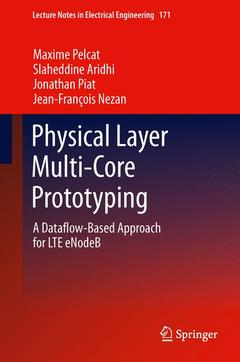Physical Layer Multi-Core Prototyping, 2013 A Dataflow-Based Approach for LTE eNodeB Lecture Notes in Electrical Engineering Series, Vol. 171
Auteurs : Pelcat Maxime, Aridhi Slaheddine, Piat Jonathan, Nezan Jean-François

Base stations developed according to the 3GPP Long Term Evolution (LTE) standard require unprecedented processing power. 3GPP LTE enables data rates beyond hundreds of Mbits/s by using advanced technologies, necessitating a highly complex LTE physical layer. The operating power of base stations is a significant cost for operators, and is currently optimized using state-of-the-art hardware solutions, such as heterogeneous distributed systems. The traditional system design method of porting algorithms to heterogeneous distributed systems based on test-and-refine methods is a manual, thus time-expensive, task.
Physical Layer Multi-Core Prototyping: A Dataflow-Based Approach provides a clear introduction to the 3GPP LTE physical layer and to dataflow-based prototyping and programming. The difficulties in the process of 3GPP LTE physical layer porting are outlined, with particular focus on automatic partitioning and scheduling, load balancing and computation latencyreduction, specifically in systems based on heterogeneous multi-core Digital Signal Processors. Multi-core prototyping methods based on algorithm dataflow modeling and architecture system-level modeling are assessed with the goal of automating and optimizing algorithm porting.
With its analysis of physical layer processing and proposals of parallel programming methods, which include automatic partitioning and scheduling, Physical Layer Multi-Core Prototyping: A Dataflow-Based Approach is a key resource for researchers and students. This study of LTE algorithms which require dynamic or static assignment and dynamic or static scheduling, allows readers to reassess and expand their knowledge of this vital component of LTE base station design.
Maxime Pelcat is an associate professor at the Department of Electrical and Computer Engineering at the National Institute of Applied Sciences (INSA) in Rennes. He holds a joint appointment in the Institute of Electronics and Telecommunications of Rennes (IETR), a CNRS research unit. Maxime Pelcat obtained his Ph.D. in signal processing from INSA in 2010. The Ph.D. thesis resulted from a collaboration of INSA Rennes and Texas Instruments, Nice, and followed a contract as research engineer. Previously, after one year in the Audio and Multimedia department at Fraunhofer-Institute IIS in Erlangen, Germany, he worked as a contractor at France Telecom Research and Development until 2006. His main research interests include dataflow models, multimedia and telecommunication processing, and programming of distributed embedded systems.
Dr. Slaheddine Aridhi is a Senior Wireless Systems Engineer in the Communications Infrastructure laboratory at Texas Instruments –France. Slaheddine Aridhi, Ph.D., is a technical expert in emerging applications for communications infrastructure. In his role as senior wireless systems engineer at Texas Instruments France (TIF), Dr. Aridhi is driving solution analyses for LTE and other emerging applications (e.g. small cells, backhaul,...) in addition to actively participating in the architecture definition of next generation devices. His efforts have enabled TI to take leadership positions in these evolving standard/proprietary applications. In his 17 years in the industry, Dr. Aridhi has gained extensive experience in wireless/digital communications research and development for digital communications, IP data networking, and wireless systems applications. Dr. Aridhi is also co-supervising a Ph.D. thesis on rapid prototyping and code generation for complex applications in collaboration with the INSA Rennes, France. Dr. Aridhi obtained his Ph.D. in wireless telecommunications from the INRS (Institut National de Re
Date de parution : 09-2014
Ouvrage de 212 p.
15.5x23.5 cm
Date de parution : 08-2012
Ouvrage de 212 p.
15.5x23.5 cm
Disponible chez l'éditeur (délai d'approvisionnement : 15 jours).
Prix indicatif 147,69 €
Ajouter au panierThème de Physical Layer Multi-Core Prototyping :
Mots-clés :
(PREESM); Advanced Software Tool Development; Long-Term Evolution (LTE); Multi-Core Programming; Parallel and Real-time Embedded Executive Scheduling Method; Rapid Prototyping Methods; Signal Processing Systems; System-Level Architecture Model (S-LAM); Telecommunications Development; Wireless Communication System Design



